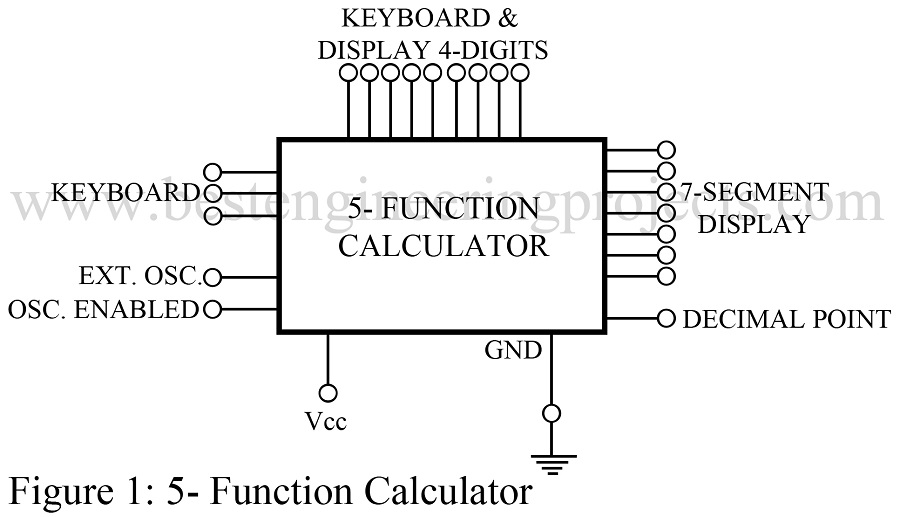A multi-function calculator is designed within a single IC such that it executes five operations which include four basic arithmetic functions and one add-on or discount percentages. It constitutes of a simple layout of a keyboard with ten numerical keys, and six function keys plus a decimal point key. This IC is a general outline of simple calculator which can perform all of the logic and storage functions in one single, 28-pin IC.
Light weight and inexpensive features add to flexibility in use of this calculator. Using the basic principle of designing a calculator as illustrated in this article, advanced calculators with complex functions that offer more than eight digits of display, more than basic five functions can be developed. However, with extensive functions, the memory can be limited.
Structure of 5-Function Calculator IC :-
Talking about the physical structure of this IC, we can see in the figure 1, in between the keyboard and the display, nine digit connections are established which are used to display the arithmetic numbers. Out of these, three lines from the keyboard are used to notify the IC which rows of keys has been pressed. This information is then combined with the digit information. When any one key from keyboard is pressed, the set of other eight digit lines are enabled and are used to illuminate the selected segments of the numeral. An external oscillator and the signal to enable oscillator are only other inputs to the IC.
Some of the key parameters described below help to understand the working of IC clearly.
- Supply voltage: – According to the desired type of display, the value of supply voltage varies.
For fluorescent-type displays, -15 V is typical,
and for LED type displays, -7.5 V is typical.
- Input signal levels: – For 15 V ICs, logic 1 ranges from -15 to -6 V and logic 0 from -1.5 to 0 V. For – 7.5 V ICs, logic 1 ranges from -7.5 to -4.0 V while logic 0 ranges from -0.5 to 0V.
- Keyboard input resistance: – For all types of calculator ICs .i.e. simple to complex, value is 1,000 ohms.
- Standby power: – It is the power used by the IC when all displays are off.
For the 15 V IC, 75 µW is typical, and 15 µW is typical for the 7.5 V IC.
- Maximum power dissipation: –It is the nominal maximum power that most calculator ICs can dissipate. At room temperature, +25 °C, this value is 500 mW.
Applications of Five Function Calculator IC
These ICs are used to design the corresponding type of calculators as desired.
BEP NOTS:
During replacing a calculator IC, one must be careful to identify the original IC manufacturer and obtain an exact pin-for-pin replacement for flawless implementation.
